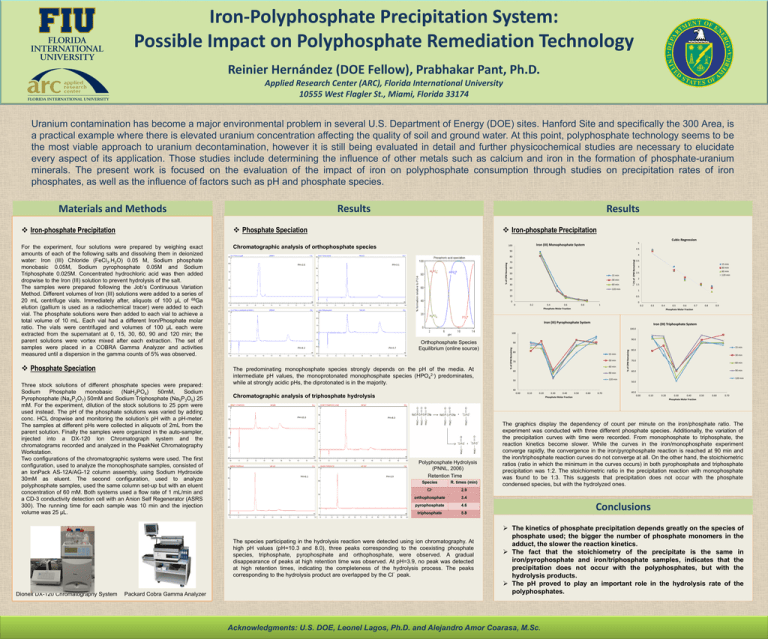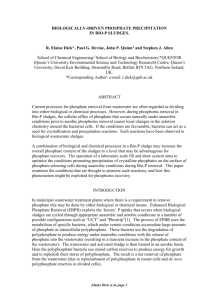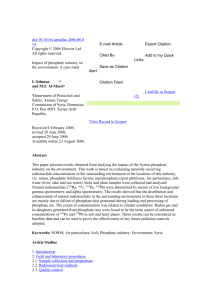Iron-Polyphosphate Precipitation System
advertisement

Iron-Polyphosphate Precipitation System: Possible Impact on Polyphosphate Remediation Technology Reinier Hernández (DOE Fellow), Prabhakar Pant, Ph.D. Applied Research Center (ARC), Florida International University 10555 West Flagler St., Miami, Florida 33174 Uranium contamination has become a major environmental problem in several U.S. Department of Energy (DOE) sites. Hanford Site and specifically the 300 Area, is a practical example where there is elevated uranium concentration affecting the quality of soil and ground water. At this point, polyphosphate technology seems to be the most viable approach to uranium decontamination, however it is still being evaluated in detail and further physicochemical studies are necessary to elucidate every aspect of its application. Those studies include determining the influence of other metals such as calcium and iron in the formation of phosphate-uranium minerals. The present work is focused on the evaluation of the impact of iron on polyphosphate consumption through studies on precipitation rates of iron phosphates, as well as the influence of factors such as pH and phosphate species. Results Materials and Methods Results Phosphate Speciation Iron-phosphate Precipitation Iron-phosphate Precipitation Cubic Regression Three stock solutions of different phosphate species were prepared: Sodium Phosphate monobasic (NaH2PO4) 50mM, Sodium Pyrophosphate (Na4P2O7) 50mM and Sodium Triphosphate (Na5P3O5) 25 mM. For the experiment, dilution of the stock solutions to 25 ppm were used instead. The pH of the phosphate solutions was varied by adding conc. HCL dropwise and monitoring the solution’s pH with a pH-meter. The samples at different pHs were collected in aliquots of 2mL from the parent solution. Finally the samples were organized in the auto-sampler, injected into a DX-120 Ion Chromatograph system and the chromatograms recorded and analyzed in the PeakNet Chromatography Workstation. Two configurations of the chromatographic systems were used. The first configuration, used to analyze the monophosphate samples, consisted of an IonPack AS-12A/AG-12 column assembly, using Sodium Hydroxide 30mM as eluent. The second configuration, used to analyze polyphosphate samples, used the same column set-up but with an eluent concentration of 60 mM. Both systems used a flow rate of 1 mL/min and a CD-3 conductivity detection cell with an Anion Self Regenerator (ASRS 300). The running time for each sample was 10 min and the injection volume was 25 µL. Packard Cobra Gamma Analyzer 4 PH=3.1 70 60 50 15 min 40 30 min 30 60 min 20 120 min 3√(% PH=2.0 of CPM Remaining) 80 3.5 15 min 30 min 60 min 120 min 3 2.5 2 1.5 1 10 0.5 0 0 0.2 0.4 0.6 0.8 0 1 0.2 0.3 Phosphate Molar Fraction 0.4 0.5 0.6 0.7 0.8 0.9 Phosphate Molar Fraction Iron (III) Pyrophosphate System Iron (III) Triphosphate System 100.0 100 PH=5.7 The predominating monophosphate species strongly depends on the pH of the media. At intermediate pH values, the monoprotonated monophosphate species (HPO42-) predominates, while at strongly acidic pHs, the diprotonated is in the majority. 90.0 90 15 min 80 15 min 30 min 70 60 min 60 90 min 120 min 50 40 0.00 Chromatographic analysis of triphosphate hydrolysis PH=10.3 PH=6.1 0.10 0.20 0.30 0.40 Phosphate Molar Fraction 0.50 0.60 0.70 % of CPM Remaining PH=4.2 Orthophosphate Species Equilibrium (online source) 80.0 30 min 70.0 60 min 90 min 60.0 120 min 50.0 40.0 0.00 0.10 0.20 0.30 0.40 0.50 0.60 0.70 Phosphate Molar Fraction PH=8.0 PH=3.9 Polyphosphate Hydrolysis (PNNL, 2006) Retention Time Species R. times (min) Cl- 2.9 orthophosphate 3.4 pyrophosphate 4.6 triphosphate 5.8 The species participating in the hydrolysis reaction were detected using ion chromatography. At high pH values (pH=10.3 and 8.0), three peaks corresponding to the coexisting phosphate species, triphosphate, pyrophosphate and orthophosphate, were observed. A gradual disappearance of peaks at high retention time was observed. At pH=3.9, no peak was detected at high retention times, indicating the completeness of the hydrolysis process. The peaks corresponding to the hydrolysis product are overlapped by the Cl peak. Dionex DX-120 Chromatography System 4.5 90 % of CPM Remaining Phosphate Speciation Iron (III) Monophosphate System 100 Chromatographic analysis of orthophosphate species % of CPM Remaining For the experiment, four solutions were prepared by weighing exact amounts of each of the following salts and dissolving them in deionized water: Iron (III) Chloride (FeCl3.H2O) 0.05 M, Sodium phosphate monobasic 0.05M, Sodium pyrophosphate 0.05M and Sodium Triphosphate 0.025M. Concentrated hydrochloric acid was then added dropwise to the Iron (III) solution to prevent hydrolysis of the salt. The samples were prepared following the Job’s Continuous Variation Method. Different volumes of Iron (III) solutions were added to a series of 20 mL centrifuge vials. Immediately after, aliquots of 100 µL of 68Ga elution (gallium is used as a radiochemical tracer) were added to each vial. The phosphate solutions were then added to each vial to achieve a total volume of 10 mL. Each vial had a different Iron/Phosphate molar ratio. The vials were centrifuged and volumes of 100 µL each were extracted from the supernatant at 0, 15, 30, 60, 90 and 120 min; the parent solutions were vortex mixed after each extraction. The set of samples were placed in a COBRA Gamma Analyzer and activities measured until a dispersion in the gamma counts of 5% was observed. 5 The graphics display the dependency of count per minute on the iron/phosphate ratio. The experiment was conducted with three different phosphate species. Additionally, the variation of the precipitation curves with time were recorded. From monophosphate to triphosphate, the reaction kinetics become slower. While the curves in the iron/monophosphate experiment converge rapidly, the convergence in the iron/pyrophosphate reaction is reached at 90 min and the iron/triphosphate reaction curves do not converge at all. On the other hand, the stoichiometric ratios (ratio in which the minimum in the curves occurs) in both pyrophosphate and triphosphate precipitation was 1:2. The stoichiometric ratio in the precipitation reaction with monophosphate was found to be 1:3. This suggests that precipitation does not occur with the phosphate condensed species, but with the hydrolyzed ones. Conclusions The kinetics of phosphate precipitation depends greatly on the species of phosphate used; the bigger the number of phosphate monomers in the adduct, the slower the reaction kinetics. The fact that the stoichiometry of the precipitate is the same in iron/pyrophosphate and iron/triphosphate samples, indicates that the precipitation does not occur with the polyphosphates, but with the hydrolysis products. The pH proved to play an important role in the hydrolysis rate of the polyphosphates. Acknowledgments: U.S. DOE, Leonel Lagos, Ph.D. and Alejandro Amor Coarasa, M.Sc.










